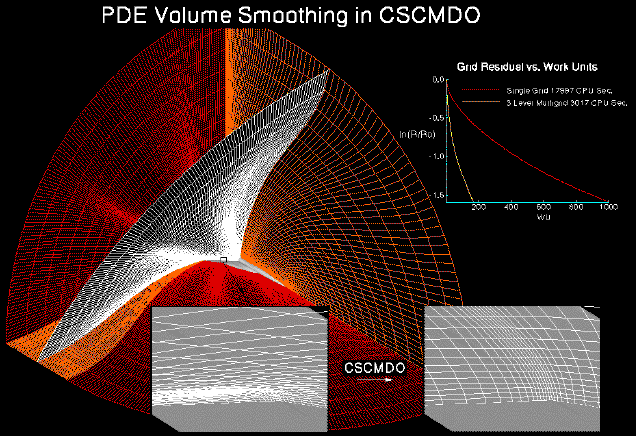NASA
High Performance Computing
and Communications Program
Computational AeroSciences Project
PDE Volume Smoothing with the Coordinate and Sensitivity Calculator for Multidisciplinary Design Optimization
Objective: Enhance the design-oriented Computational Fluid Dynamics (CFD) volume grid generator CSCMDO, which modifies CFD volume grids to reflect surface geometry changes arising in an automated optimization process, through the addition of efficient volume grid smoothing methods.
Approach: The Coordinate and Sensitivity Calculator for Multidisciplinary Design Optimization (CSCMDO) is an existing general purpose multiblock CFD volume grid generator which is design-oriented, i.e., which has specialized features which permit the automated modification of an original baseline volume grid to reflect the surface geometry changes that arise in an optimization process and which provides the sensitivity derivatives of the volume grid with respect to the surface geometry design variables. Previously CSCMDO relied on the availability of an initial volume grid of good quality. Volume grid modification was based on a variety of algebraic techniques and Partial Differential Equation (PDE) surface smoothing methods. The recent work focused on the addition of efficient volume grid smoothing and better control over boundary spacing and intersection angles.
Accomplishments: The enhancements to CSCMDO lessen the need for a high quality initial grid and improve the overall quality of volume grids generated by it during an optimization process. Grid quality is a much more serious issue for viscous than for inviscid computations. In addition to smoothing the volume grid, control over boundary gridpoint spacings and intersection angles is provided by specially selected forcing functions. A Multigrid (MG) convergence acceleration technique is employed to provide accurate and efficient solution of the grid generation PDEs. The figure demonstrates the use of the MG grid smoother applied to a typical wing/fuselage High Speed Civil Transport (HSCT) configuration. The addition of PDE volume smoothing as well as boundary spacing and intersection angle control to the CSCMDO volume grid generator is critical to providing the robust generation of the highest quality grids for viscous flow modeling about complex configurations. The MG convergence acceleration techniques provide an efficient method for solving the system of grid generation PDEs as is seen in the convergence history plot of the figure. (Computer times are for an SGI workstation with dual R10000 CPUs.) Grid sensitivities to the surface geometry design variables are also provided by CSCMDO. This has been accomplished through the application of the automatic differentiation tool ADIC, developed by Argonne National Laboratory. These sensitivity derivatives are required for using CSCMDO together with a CFD code in a gradient-based optimization scheme.
Significance: The CSCMDO multi-purpose volume grid modification tool removes the human from the labor intensive grid generation phase of the design loop by providing for the automated update of high quality viscous CFD volume grids and their sensitivity derivatives for use in the optimization process. Efficient solution of the grid generation PDEs, with boundary control, is necessary for the fast, robust generation of high quality grids about complex geometry.
Status/Plans: The addition of the 3- dimensional volume grid smoothing with boundary control concludes the development of CSCMDO. Future work will be restricted to code maintenance and application.
William T. Jones
Computer Sciences Corporation
(757) 864 - 5318
email : w.t.jones@larc.nasa.gov
